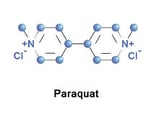When I first saw EPA Method 549.2 only had two compounds, I said to myself: “WOW! That’s a breeze! Only two compounds to worry about, so it can’t be that difficult to extract!”Seeing as I was used to the methods with 100+ compounds to worry about, naturally, I would believe this at first glance. However, I was severely mistaken…these two compounds are far from easy to recover from a water sample. To be successful with EPA Method 549.2, you need to make sure you have the right chemistries taking place in order to recover these compounds well or even at all.
What are diquat and paraquat?
Diquat and paraquat are types of herbicides. They were one of the most-4.jpg?width=137&height=137&name=bigstock--187198042%20(1)-4.jpg) commonly used herbicides around the world until it was discovered that these compounds were toxic to humans. The whole purpose for using these herbicides was to prevent invasive plants from overtaking farmer’s crops and improve production, but at what cost? Hurray!
commonly used herbicides around the world until it was discovered that these compounds were toxic to humans. The whole purpose for using these herbicides was to prevent invasive plants from overtaking farmer’s crops and improve production, but at what cost? Hurray!
Farmers were able to save their crops and sell them to consumers…however, once the food was ingested, so was the toxic chemical along with it because even if the produce was rinsed with soap and water, the herbicides would remain on the produce, and ultimately these toxins would end up in our bodies.
How do I extract these compounds?
The EPA developed method 549.2 to monitor these compounds in drinking water. Using a C8 cartridge or disk, these compounds can be extracted from drinking water using the proper solvents outlined within the method.
What can cause these extractions to be so difficult?
There are several reasons and interferences that can cause problems with recovering these compounds. To understand these issues, you must take a look at their chemical characteristics first. These compounds are quaternary amines meaning they are positively charged. You may think, well what if I pH adjust my samples? Unfortunately, that will not work as these charges cannot be neutralized by a pH adjustment. This poses a major challenge because these compounds tend to stick to negative silanol groups of glass surfaces, and it is nearly impossible to remove them from the glass. In order to successfully recover diquat and paraquat, you need to make sure that these compounds will not encounter glass during the extraction process. Therefore, you want to make sure that your sample bottles, extraction apparatus, and collection vessel do not contain glass. If for some reason you have no other option and you can only use glass, you want to make sure this glass has undergone silanization. However, this is an added step in your process, and is difficult to maintain.
Next, one must consider the extraction media used and what format it needs to be in. For instance, you can use C8 LSE media or anything equivalent. However, you must consider the format that this media is in. If you are looking into disk format, you will need to ensure that the base of this disk is not glass fiber, as it will be nearly impossible to extract the compounds from the glass fiber disk (as was discussed in the previous point). Alternatively, it can be in cartridge format, so long the frits are not made of glass either. It is very important to make sure that all parts of the extraction process are researched before implementing this method into your laboratory’s workflow.
Lastly, some samples may be considered “hard water” meaning they contain calcium and magnesium ions. Since they are divalent cations, they could interact with the negatively charged ion exchange sorbent, decreasing the sorbent capacity, and preventing the compounds of interest (diquat and paraquat) from recovering. To mitigate this potential issue, it is recommended that you have a sample of water from the sampling site, then spike the sample with a known amount of diquat and paraquat in the laboratory (also known as a laboratory fortified sample matrix (LFM)), to determine the accuracy of compound recovery at this sampling site.
You can imagine my surprise when I realized extracting two compounds from a sample matrix deemed more challenging than an entire suite of compounds, however, based on the chemistries that are happening with these two herbicides, it all makes sense now! Just be sure to follow the method recommendations to ensure that you are doing a good job monitoring these herbicides in your drinking water samples.
Download our latest application note for more information!

 Organic Workflow
Organic Workflow Peptide Workflow
Peptide Workflow Scale-Up Flash Purification
Scale-Up Flash Purification  Sample Preparation
Sample Preparation Biomolecule Purification
Biomolecule Purification Oligo synthesis
Oligo synthesis Scavengers and Reagents
Scavengers and Reagents Service & Support
Service & Support Accessories & Spare parts
Accessories & Spare parts Investors
Investors Reports & News
Reports & News The Share
The Share Corporate Governance
Corporate Governance Calendar
Calendar Sustainability
Sustainability Our Offering
Our Offering Our History
Our History Our Locations
Our Locations Leadership
Leadership